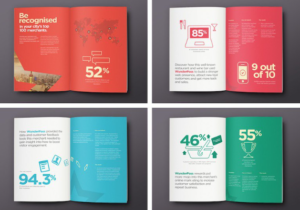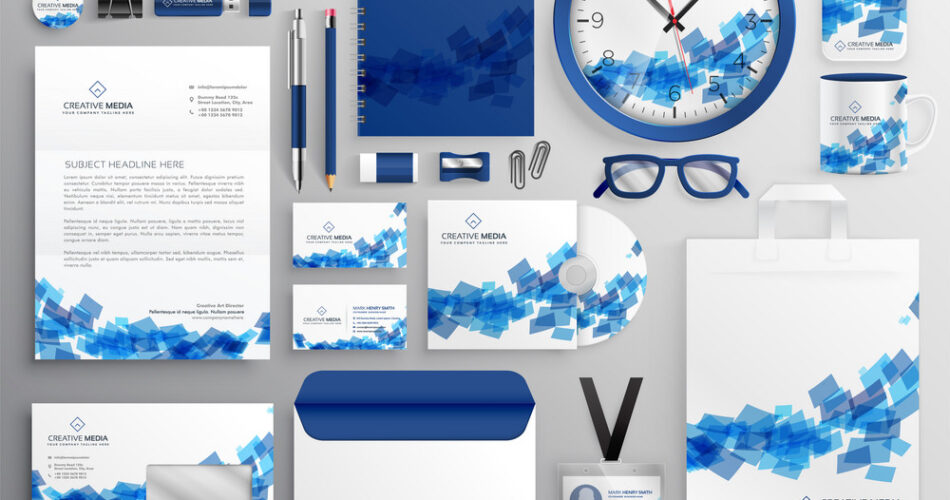In today’s competitive business landscape, first impressions matter more than ever. business collateral design plays a crucial role in how your company is perceived by potential clients, partners, and investors. From the moment someone holds your business card to when they browse your digital brochure, every piece of collateral tells a story about your brand’s professionalism, attention to detail, and commitment to quality.
This comprehensive guide will explore every aspect of business collateral design, providing you with actionable insights to create materials that not only look stunning but also effectively communicate your brand message. Whether you’re a startup looking to establish your visual identity or an established corporation aiming to refresh your materials, this guide will walk you through the entire process of designing collateral that makes an impact.
Contents
- 1 Understanding the Power of Business Collateral
- 2 The Evolution of business collateral design in the Digital Age
- 3 Comprehensive Breakdown of business collateral design Types
- 3.1 Business Cards: Your Portable First Impression
- 3.2 Brochures and Catalogs: Telling Your Product Story
- 3.3 Presentation Folders: Organizing Professionalism
- 3.4 Corporate Stationery: The Foundation of Business Communication
- 3.5 Signage and Environmental Graphics
- 3.6 Digital Collateral: The Virtual Brand Experience
- 4 The Science Behind Effective Collateral Design
- 5 The Collateral Design Process: Step by Step
- 6 Common Collateral Design Mistakes to Avoid
- 7 The Future of Business Collateral Design
- 8 Conclusion: Elevating Your Brand Through Thoughtful business collateral design
Understanding the Power of Business Collateral

Business collateral encompasses all the physical and digital materials that represent your company in the marketplace. These materials serve as tangible extensions of your brand, working silently yet powerfully to reinforce your messaging and values. When designed effectively, business collateral can:
- Establish immediate brand recognition
- Build credibility and trust with your audience
- Differentiate you from competitors
- Support your sales and marketing efforts
- Provide valuable information to potential customers
- Create lasting impressions that lead to business opportunities
The psychology behind effective collateral design is fascinating. Studies show that people form first impressions within seconds, and these initial judgments are heavily influenced by visual cues. A well-designed business card or brochure doesn’t just convey information—it evokes emotions and creates associations that can determine whether someone chooses to do business with you.
The Evolution of business collateral design in the Digital Age
While the fundamentals of good design remain constant, business collateral has evolved significantly with technological advancements. Traditional printed materials now coexist with digital counterparts, each serving unique purposes in your overall marketing strategy.
Printed collateral continues to hold significant value, especially in industries where personal relationships matter. There’s something inherently powerful about the tactile experience of holding a well-crafted brochure or the weight of a premium business card. These physical items often stay on a prospect’s desk long after a digital file might be forgotten.
Digital collateral, on the other hand, offers unparalleled reach and interactivity. From PDF brochures that can be instantly shared worldwide to interactive presentations that engage viewers, digital formats provide flexibility that print cannot match. The most successful businesses today leverage both formats strategically, ensuring their brand experience remains consistent across all touchpoints.
Comprehensive Breakdown of business collateral design Types
To fully grasp the scope of business collateral design, let’s examine the most common types in detail:
Business Cards: Your Portable First Impression
The humble business card remains one of the most powerful networking tools. A well-designed card should instantly communicate your brand identity while providing essential contact information. Modern business card design has moved beyond simple rectangles with contact details—today’s most effective cards incorporate:
- Unique shapes and cutting techniques
- Special finishes like spot UV, foil stamping, or embossing
- Smart use of both sides for maximum information impact
- QR codes that bridge the physical-digital divide
- Environmentally friendly materials for eco-conscious brands
Brochures and Catalogs: Telling Your Product Story
Brochures serve as your brand’s storytellers, providing detailed information about your products or services. Effective brochure design requires careful consideration of:
- Information hierarchy to guide readers through content
- Strategic use of imagery to showcase products or services
- Clear section divisions for easy navigation
- Compelling calls-to-action that drive engagement
- Paper stock selection that aligns with your brand image
Catalogs take this a step further, requiring sophisticated organizational systems to help customers find what they need quickly. The best catalogs balance aesthetic appeal with practical functionality.
Presentation Folders: Organizing Professionalism
Often overlooked, presentation folders serve as the packaging for your important documents. A well-designed folder:
- Protects enclosed materials while making them look more valuable
- Provides pockets for business cards, brochures, and other inserts
- Features your logo prominently for brand reinforcement
- Uses quality materials that convey professionalism
Corporate Stationery: The Foundation of Business Communication
Your letterheads, envelopes, and notepads may seem mundane, but they represent your brand in every correspondence. Consistent stationery design:
- Creates a professional image for all written communications
- Reinforces brand recognition with every piece of mail sent
- Provides a cohesive look across all office documents
- Can include subtle security features for official documents
Signage and Environmental Graphics
From office lobby signs to trade show displays, environmental graphics make physical statements about your brand. Effective signage design considers:
- Visibility from various distances and angles
- Durability of materials for long-term use
- Compliance with local regulations and ADA requirements
- How the design integrates with architectural elements
Digital Collateral: The Virtual Brand Experience
In our increasingly digital world, your online collateral must be as carefully crafted as physical materials. Key digital collateral includes:
- Email templates that maintain brand consistency
- Social media graphics optimized for each platform
- Interactive PDFs that engage readers
- Digital flipbooks that recreate the magazine experience
- Website elements that align with your printed materials
The Science Behind Effective Collateral Design
Creating impactful business collateral isn’t just about making things look pretty—it’s about understanding how people process visual information and make decisions. Let’s examine the psychological principles that should guide your design choices:
Visual Hierarchy: Guiding the Eye
The human eye naturally follows certain patterns when viewing a page. Effective designs use:
- Size variation to indicate importance
- Strategic placement of key elements
- Color contrast to draw attention
- White space to prevent overwhelm
Color Psychology in Branding
Colors evoke specific emotional responses. While individual reactions can vary based on personal experiences, general associations include:
- Blue: Trust, stability, professionalism
- Green: Growth, health, sustainability
- Red: Energy, urgency, excitement
- Yellow: Optimism, creativity, warmth
- Black: Luxury, sophistication, power
Your color choices should align with your brand personality and the emotions you want to evoke in your audience.
Typography That Speaks Volumes
Fonts carry personality just as much as colors do. Consider:
- Serif fonts for traditional, respectable industries
- Sans-serif for modern, approachable brands
- Script fonts for luxury or creative businesses
- The importance of readability at various sizes
- Maintaining font consistency across all materials
The Power of Imagery
Photographs and illustrations can communicate complex ideas instantly. Best practices include:
- Using authentic, high-quality images
- Ensuring photos reflect your actual team/products
- Maintaining consistent visual style across all images
- Optimizing file sizes for different applications
The Collateral Design Process: Step by Step
Creating effective business collateral requires a systematic approach. Here’s a comprehensive workflow to ensure professional results:
1. Define Your Objectives
Before opening any design software, clarify:
- Who is this collateral for? (Target audience)
- What action should they take after viewing it?
- What information must be included?
- How will this piece be distributed?
2. Gather Brand Assets
Collect all existing brand guidelines including:
- Logo files in various formats
- Approved color palettes with Pantone, CMYK, and RGB values
- Brand fonts with usage guidelines
- Existing imagery or photo style guides
- Tone of voice documentation
3. Content Development
Work with copywriters to craft messaging that:
- Speaks directly to your target audience
- Highlights benefits rather than just features
- Maintains consistent brand voice
- Includes clear calls-to-action
4. Wireframing and Layout
Create rough sketches or digital wireframes to plan:
- Information flow and hierarchy
- Space allocation for different elements
- Balance between text and visuals
- Overall composition and pacing
5. Design Execution
Using professional design software:
- Implement the approved layout
- Apply brand colors and typography
- Incorporate high-quality visuals
- Ensure all elements align perfectly
6. Proofing and Testing
Before final production:
- Check for spelling and grammatical errors
- Verify all contact information is current
- Test readability at actual size
- Get feedback from sample audience members
7. Production and Distribution
Choose the right production method based on:
- Quantity needed
- Budget constraints
- Desired quality level
- Environmental considerations
Common Collateral Design Mistakes to Avoid
Even experienced marketers can fall into these traps:
Overdesigning
Trying to include too many effects or elements can:
- Make the piece visually confusing
- Increase production costs unnecessarily
- Distract from the core message
Inconsistent Branding
Using different colors, fonts, or styles across materials:
- Weakens brand recognition
- Creates confusion about your identity
- Makes your business appear disorganized
Poor Quality Production
Cutting corners on materials or printing:
- Makes your brand look cheap
- Reduces perceived value of your offerings
- Can lead to durability issues
Ignoring the Audience
Designing for personal preference rather than:
- What resonates with your target market
- What’s appropriate for your industry
- What facilitates the desired action
The Future of Business Collateral Design
As technology advances, collateral design continues to evolve. Emerging trends include:
Augmented Reality Integration
AR transforms static printed materials into interactive experiences by:
- Bringing products to life through animation
- Providing additional content layers
- Creating memorable brand interactions
Sustainable Materials
Eco-conscious design focuses on:
- Recycled and biodegradable materials
- Soy-based inks and green printing processes
- Designs that minimize waste
Hyper-Personalization
Variable data printing and digital tech allow for:
- Pieces tailored to individual recipients
- Localized content variations
- Real-time content updates
Seamless Digital-Physical Integration
Innovations like:
- NFC-enabled business cards
- QR codes with dynamic destinations
- Printed materials with digital triggers
Conclusion: Elevating Your Brand Through Thoughtful business collateral design
Exceptional business collateral design is both an art and a science. It requires equal parts creativity and strategy, aesthetics and psychology. When executed well, your collateral becomes more than just marketing materials—it becomes an extension of your brand’s personality and values.
Remember that every piece you create, from the simplest business card to the most elaborate trade show display, contributes to how your company is perceived. Consistency across all touchpoints builds recognition, while quality execution builds trust.
